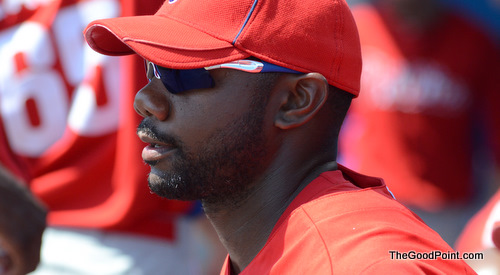
Ryan Howard: The story that got no press
For the first time in three years, Philadelphia Phillies slugger Ryan Howard will have the option of watching the MLB All-Star Game from the comfort of his own living room.
Instead of representing his club in the Midsummer Classic he will, as any professional would, take the opportunity to rest up and prepare for the second half of the season – one which, given Philly’s dominance through the season’s first few months, could ultimately lead to the organization’s first World Series win since, well, since the last time Howard’s name was left off the list.
Besides, nobody ever said standing out amongst National League first basemen was easy, anyway.
The 31-year-old may not be hitting for average as he has historically (in his previous three All-Star seasons he’s hit .313, .279 and .276 respectively, this year sub-.260), but his on-base percentage, thanks to an increased walk total, suggests that his squad is no worse for wear as a result.
Sure his slugging percentage may have dipped to a career low (currently .100 below National League starter Prince Fielder), but at least he’s found within himself some other means of rivalling the RBI rate that has made him one of the generation’s most lethal offensive threats.
The important thing to take away from the number crunching is that, sure, Howard may not be pumping out the statistical masterpieces of Fielder or Boston’s Adrian Gonzalez – perhaps not even NL All-Star team reserves Joey Votto and Gaby Sanchez – but he hasn’t exactly been chopped liver either.
[php snippet=1]
Call it a snub, call it a mistake, call it whatever you want, but there really is no denying the one common theme that has directly contributed to his All-Star Game omission. It’s something he’s been well aware of since Spring Training.
For perhaps the first time in Howard’s everyday reign with the franchise, the world isn’t paying attention to him. Blame those pitchers of theirs – three of whom will take the mound on Tuesday night.
“As far as what everybody wants to pay attention to, that’s fine by me. The hitters, we go out there and do our job, that’s just doing our normal job,” Howard told The Good Point last March. “Wherever you want to put your focus, that’s not going to change the fact that we’re going to go out there and do our job.”
It may not be fair in the grand scheme of things, but neither Howard nor even legendary middle infielders Chase Utley and Jimmy Rollins, would have it any other way if it meant they had to go back to sharing responsibility for leading the Phils back to where they left off in 2008 alone.
“It’s cool, there are no egos,” Howard said. “We all get along.”
The bonds that have formed within the rotation, within the lineup and throughout the team have led to a fully-functioning product that currently leads all of Major League Baseball in the standings.
The resulting juggernaut has made headlines since the re-acquisition of Cliff Lee last December. Headlines that, though welcomed, do tend to veil the fact that nestled within the clubhouse remains an army of more than capable hitters able to shoulder the load offensively when, or if, the pitching ever struggles.
“All those guys just feed off each other,” he said, making the obvious distinction that it was the addition of the 2008 Cy Young award winner over the offseason that pushed the club over the top.
Though it caught sportswriters off guard when Lee passed on offers from both the New York Yankees and Texas Rangers, his presence in the clubhouse had already been established over the course of the 2009 campaign.
For others, like Roy Halladay, acquired only in December of 2009, the adjustment has been more gradual.
“He has fun, kind of clowns around a little bit,” said Howard. “When he first got here he was real quiet, but now he’s kinda opened up a little bit. And that’s a good thing.”
As the team’s comfort level has risen, so too have the spirits of Phillies fans who remember all too well what it was like to have their reign at the top of the baseball world cut short by the Yankees in 2009.
In an effort to guide his team – the same one that drafted him in the fifth round of the 2001 MLB Draft – back to the top, Howard has embraced the fact that regardless of how much praise his pitchers get from fans and the media, they won’t win ball games without an offense to put runs on the board.
Over the course of the past offseason Howard put particular care into how he shifts his weight as he transitions through his swing, a modification that has led to a rediscovered ability to draw walks at the plate.
“I just try to work on everything. Work on the weight transfer, work from the weight standpoint. Try to get my body in the best shape that I can,” he said.
If his season continues in the second half as it has in the first, Howard may not match any of the otherworldly career highs he set during the past half-decade (like 58 home runs and 149 RBIs with a 1.084 OPS), but it may end up being one of the most rewarding.
Even if the Phillies hold it all together and their revolutionary rotation gets all the credit for a 2011 title, it won’t matter. He and his hitters will have done their jobs and done them well. If people don’t want to pay attention, it will only be their loss.
[php snippet=1]

